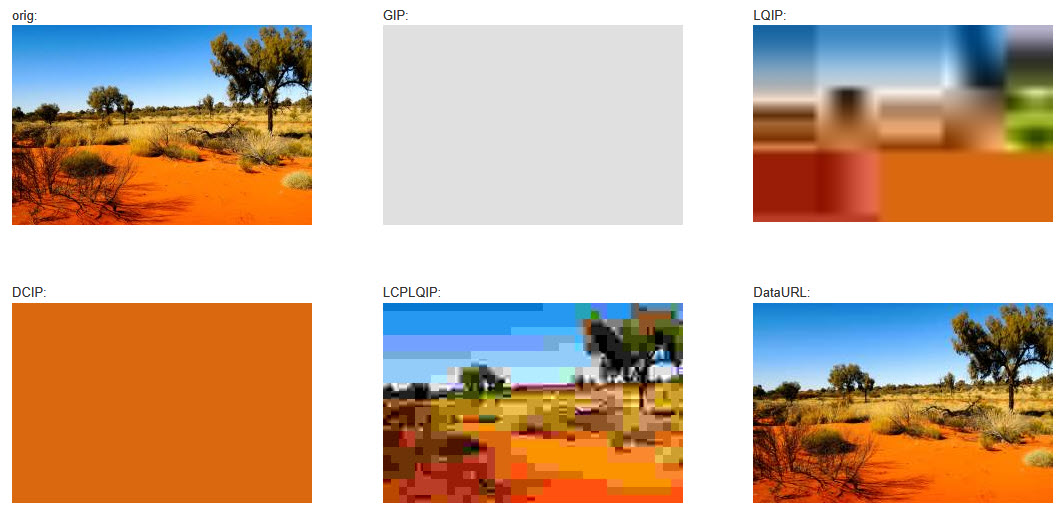innoweb / silverstripe-image-placeholders
Provides low quality, greyscale and data64 conversions for Image placeholders
Installs: 185
Dependents: 0
Suggesters: 0
Security: 0
Stars: 1
Watchers: 1
Forks: 1
Open Issues: 0
Type:silverstripe-vendormodule
pkg:composer/innoweb/silverstripe-image-placeholders
Requires
- ext-gd: *
- ksubileau/color-thief-php: ^2
- silverstripe/assets: ^3
README
Overview
This modules provides:
- LQIP (low quality image placeholder)
- GIP (greyscale image placeholder)
- DCIP (dominant color image placeholder)
- DataURL (base64 encoded image data)
It also contains a method for LCP LQIP described by Harry Roberts which lets you use a LQIP so that it counts as the LCP image and the hi-res image gets swapped in later on. Thanks Harry for this wizardry ;)
Requirements
- Silverstripe Assets ^3 (Silverstripe ^6)
- ksubileau/color-thief-php ^2
Installation
Install the module using composer:
composer require innoweb/silverstripe-image-placeholders dev-master
Then run dev/build.
Usage
Important
Make sure that any resizing is done prior to generating the placeholder image.
Do: <img src="$Image.Fill(200,200).GIP.DataURL" width="200" height="200">
Don't: <img src="$Image.GIP.Fill(200,200).DataURL" width="200" height="200">
LQIP, GIP and DCIP are smaller versions of the original image. Always write your own image tags
with width and height attributes to make sure the image gets rendered correctly.
Lazy loading via Javascript
You can use these placeholders for images that are lazy loaded via Javascript, e.g.:
<img src="$Image.LQIP.DataURL"
data-src="$Image.URL.ATT"
width="$Image.Width"
height="$Image.Height"
class="lazyload">
And then use lazysizes to load the images.
This uses the Base64 encoded data URL of the LQIP as a placeholder and then lazy loads the hi-res image.
Native lazy loading
You can also use these placeholders for images that are lazy loaded natively:
<img src="$Image.URL.ATT"
width="$Image.Width"
height="$Image.Height"
style="background-image: url($Image.LQIP.DataURL);
background-repeat: no-repeat;
background-size: cover;"
loading="lazy">
This uses the Base64 encoded data URL of the LQIP as a background of the image that is displayed while the actual image is loaded.
Placeholder for LCP image
Harry Roberts describes in a blog post how a LQIP can be set so that it counts as the LCP image and the hi-res image gets swapped in later on.
This module supports this behaviour with the LCPLQIP method.
You can set the bits per pixel (BPP) threshold described by Google using the following setting:
Innoweb\ImagePlaceholders\ImageExtension:
min_bits_per_pixel: 0.055
Per default this is set to 0.055, which gives the value defined by Google another 10% to be on the safe side.
To use the LCP LQIP image, preload the LQIP image and set it as background for the actual image:
<head>
...
<link rel="preload" as="image" href="$Image.LCPLQIP.URL.ATT" fetchpriority="high">
...
</head>
<body>
...
<img src="$Image.URL.ATT"
width="$Image.Width"
height="$Image.Height"
style="background: #eee url($Image.LCPLQIP.URL.ATT) no-repeat;
background-size: cover;">
...
</body>
This way, the LQIP image is already loaded when the page is rendered and the hi-res image is then downloaded and swapped in. (The CSS background colour is used as another fallback, in case the LQIP is not available yet.)
Because the LCPLQIP image is over the BPP threshold and the hi-res image has the same dimensions
as the LCPLQIP image, the LCPLQIP image is counted as the LCP image instead of the hi-res image.
Examples
Here are some examples of the code and the resulting images:
<p>orig:<br>$Image.Quality(80).Fill(300,200)</p> <p>GIP:<br><img src="$Image.Fill(300,200).GIP.URL" width="300" height="200"></p> <p>LQIP:<br><img src="$Image.Fill(300,200).LQIP.URL" width="300" height="200"></p> <p>DCIP:<br><img src="$Image.Fill(300,200).DCIP.URL" width="300" height="200"></p> <p>LCPLQIP:<br>$Image.Fill(300,200).LCPLQIP</p> <p>DataURL:<br><img src="$Image.Fill(300,200).DataURL" width="300" height="200"></p>
License
BSD 3-Clause License, see License

